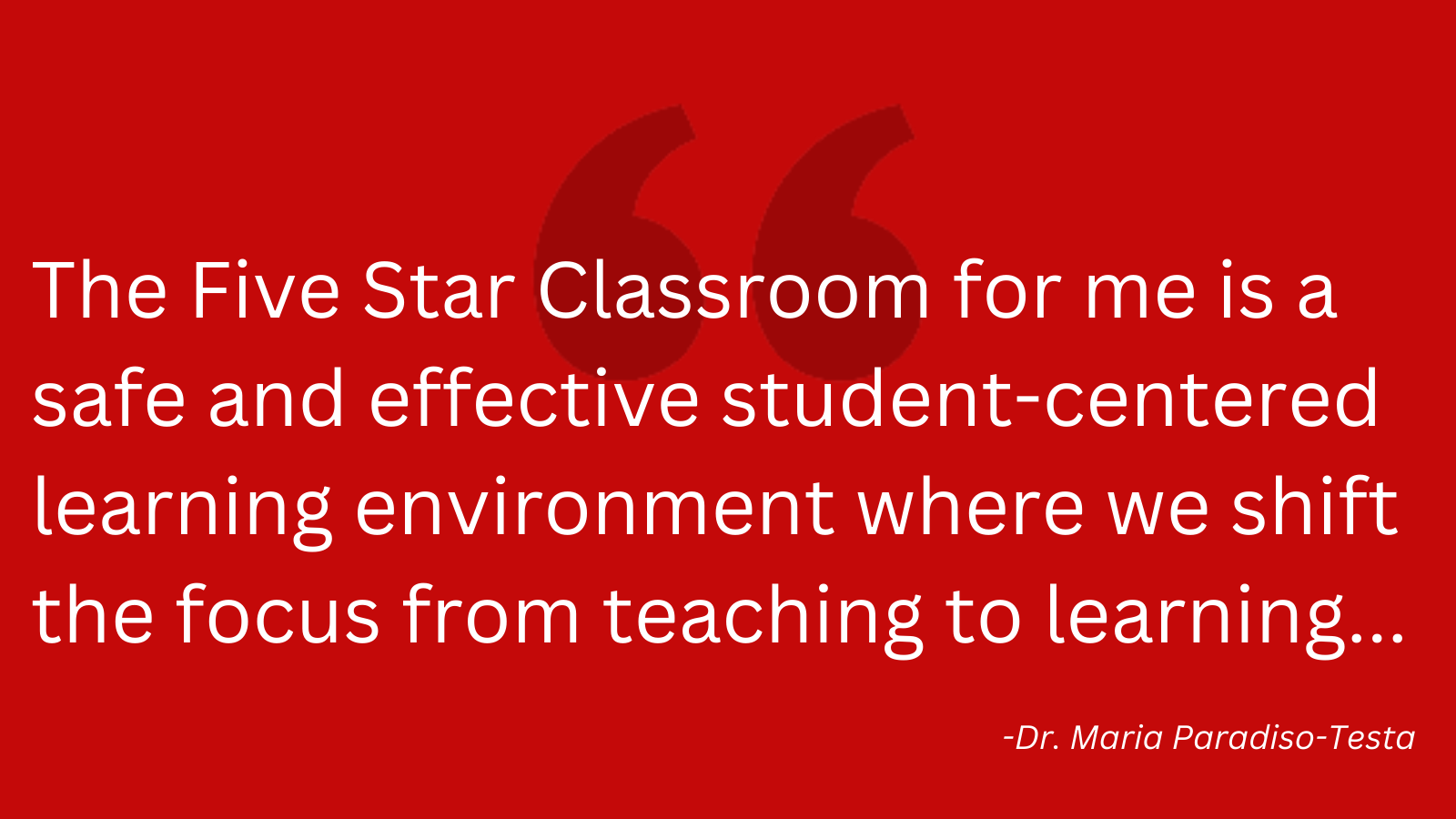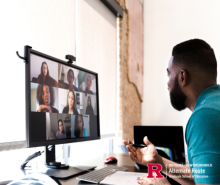How NJ Teachers Can Create A Five Star Classroom Experience for Students
Teachers join the education profession make a lasting contribution in the lives of young people. The first order of business for achieving this goal is creating a classroom environment that fosters educational excellence. Experienced classroom teacher, administrator, and professor of education Dr. Paradiso-Testa has created a winning formula for this. She calls it the Five-Star Classroom, and she shared it with new teachers enrolled with the Rutgers Alternate Route Program as part of our Content Conversation Series. Dr. Testa's model encourages teachers to create a student-centered learning environment that includes voice, visibility, and value for each student. Her Five-Star Classroom model prioritizes a holistic approach to education that goes beyond academic excellence and emphasizes the importance of emotional development, community partnerships, and inclusivity. This blog post explores the various pillars of the Five-Star Classroom model in detail and unpacks the key insights and resources from this transformative session.
What Pillars Comprise A Five-Star Classroom?
Dr. Paradiso-Testa's "Five-Star Classroom" is a model for achieving educational excellence. She begins by explaining, “The Five Star Classroom for me is a safe and effective student-centered learning environment where we shift the focus from teaching to learning.” It consists of five pillars--student-centered learning environment, culture, diversity, equity, and inclusivity, social-emotional learning, partners in education, and academic rigor. The model emphasizes creating a safe and adaptable learning environment, integrating diverse cultures into the curriculum, nurturing emotional intelligence, forging partnerships with families and the community, and fostering critical thinking and problem-solving skills. By integrating these pillars into the educational framework, Dr. Paradiso-Testa envisions a classroom where students are not just learners but active participants in their education journey.
Here's a more detailed breakdown of the pillars she promotes:
Student-Centered Learning Environment: This isn't just about tailoring lessons to individual student needs. It's about creating an environment where students feel safe to express themselves, ask questions, and take risks in their learning journey. It emphasizes the importance of adaptability in teaching methods to cater to diverse learning styles.
Culture, Diversity, Equity, and Inclusivity: Beyond recognizing the diverse backgrounds of students, this pillar emphasizes the importance of integrating diverse cultures into the curriculum. It's about celebrating differences, addressing biases, and ensuring every student feels seen and respected.
Social Emotional Learning: More than just academic achievements, this focuses on nurturing students' emotional intelligence. It's about teaching empathy, resilience, and interpersonal skills, ensuring students are well-equipped to handle challenges both inside and outside the classroom.
Partners in Education: This isn't just about parent-teacher meetings. It's about forging genuine partnerships with families, local businesses, and community organizations. By doing so, learning becomes a collaborative effort, enriched by diverse perspectives and resources.
Academic Rigor: This pillar pushes for a curriculum that challenges students, ensuring they're not just memorizing facts but truly understanding and applying their knowledge. It's about fostering critical thinking, problem-solving skills, and a genuine love for learning.

Five Star Classrooms Value Families
Dr. Paradiso-Testa underscored the importance of forging strong ties with families to enhance the educational journey, noting that “It takes a village to raise a child. No one does anything alone…We're created and designed to work with each other to help and support each other.” She emphasized the value of recognizing family cultural strengths and how understanding the daily lives of students and their families help with this goal. To that end, teachers must be attentive to practices of active listening, involving families in curriculum planning, regular communication, community engagement events, and feedback mechanisms—all of which foster positive communication for forging strong family ties. Such positive communication, in turn, helps to build trust among families, which plays a critical role in maintaining teacher-parent partnerships with the goal of helping children succeed. By implementing these strategies, educators can ensure a more inclusive and collaborative learning environment, where the lines between home and school are seamlessly blended.
Here's a more detailed breakdown of the practices she highlighted:
Active Listening: Taking the time to genuinely listen to families' concerns, insights, and stories about their children. This not only fosters trust but also provides valuable context for educators.
Involving Families in Curriculum Planning: By involving families in the planning process, educators can ensure that the curriculum is relevant and resonates with students' backgrounds and experiences.
Regular Communication: Keeping families updated about their children's progress, upcoming events, and any challenges faced. This can be through regular meetings, newsletters, or digital platforms.
Community Engagement Events: Organizing events where families can participate in school activities, workshops, or discussions, fostering a sense of community and collaboration.
Feedback Mechanisms: Creating channels where families can provide feedback, share concerns, or offer suggestions, ensuring that their voices are heard and valued.
Five-Star Benefits of Co-Teaching
Dr. Paradiso-Testa reminded teachers that every student is unique and that various learning styles are represented in our classes. She explained, “Different ways students learn are verbally, logically, mathematically, visually, hands-on, interpersonally, and naturalistically. It is critical for us not to take a student out of one way of learning.” That’s where co-teaching can help. Co-teaching, often referred to as collaborative teaching, involves two or more teachers working together in the same classroom to deliver instruction to a group of students. This collaborative approach offers diverse instructional strategies, increased individual attention, enhanced classroom management, professional growth, flexibility, support for diverse learners, and shared responsibility. Co-teaching can take various forms, such as one teacher leading the lesson while the other provides support, both teachers sharing the instruction equally, or teachers dividing the class into smaller groups and delivering tailored instruction. In essence, co-teaching harnesses the strengths of multiple educators to create a more dynamic, responsive, and effective classroom environment.
The benefits below demonstrate why it’s worth adding co-teaching to your professional practice:
Diverse Instructional Strategies: With two educators in the room, there's a broader range of teaching methods and styles available. This diversity can cater to different learning styles, ensuring that more students grasp the material.
Increased Individual Attention: With more than one teacher present, students can receive more individualized attention, which can be especially beneficial for those who need additional support or enrichment.
Enhanced Classroom Management: Two teachers can more effectively manage classroom behavior, ensuring a conducive learning environment.
Professional Growth: Co-teaching offers educators the opportunity to learn from each other, share best practices, and refine their teaching methods.
Flexibility: Teachers can easily divide the class for group activities, allowing for more tailored instruction based on student's abilities or interests.
Support for Diverse Learners: In a co-teaching setting, teachers can better address the needs of students with disabilities, English language learners, or those who need academic interventions, ensuring inclusivity.
Shared Responsibility: The collaborative nature of co-teaching means that teachers can share the responsibilities of lesson planning, assessment, and feedback, reducing individual workload and stress.
Resources for continuous learning
Dr. Paradiso-Testa emphasized the importance of continuous learning and provided attendees with a curated list of resources to help them further understand and implement the principles of the Five-Star Classroom. Notably, she recommended video clips that serve as conversation starters about classroom culture and student engagement. One such clip was the trailer for the movie "Freedom Writers," a film that delves into the challenges and rewards of teaching in a diverse classroom setting. Another recommendation was a music video by a fourth-grade teacher named Mr. Reed, which showcases innovative ways to connect with students and make learning engaging. These resources, among others shared, are designed to inspire educators and provide practical insights into creating an uplifting classroom environment.

 Sharlene Laud has extensive experience in education from K-12 to higher education and holds a Doctorate in Education from the Rutgers Graduate School of Education. Dr. Laud is the Assistant Director of the Rutgers-GSE Alternate Route Program in the Department of Learning and Teaching. Follow her on X @sharlene_laud
Sharlene Laud has extensive experience in education from K-12 to higher education and holds a Doctorate in Education from the Rutgers Graduate School of Education. Dr. Laud is the Assistant Director of the Rutgers-GSE Alternate Route Program in the Department of Learning and Teaching. Follow her on X @sharlene_laud





